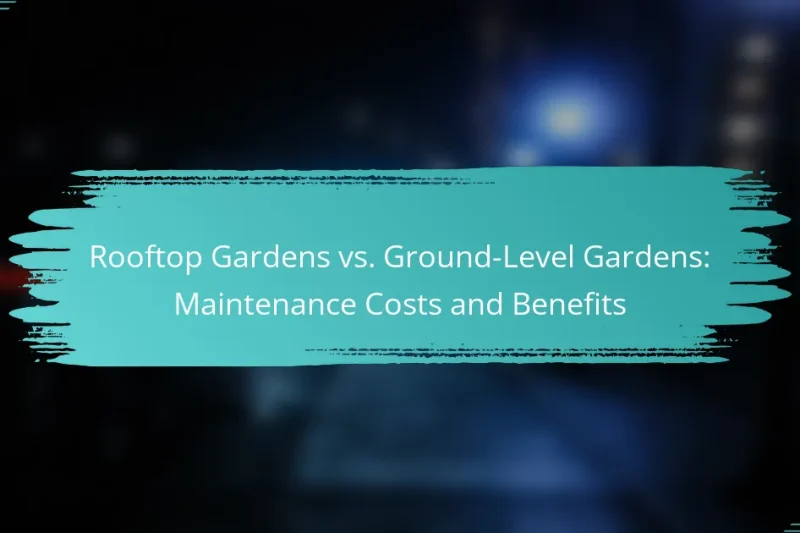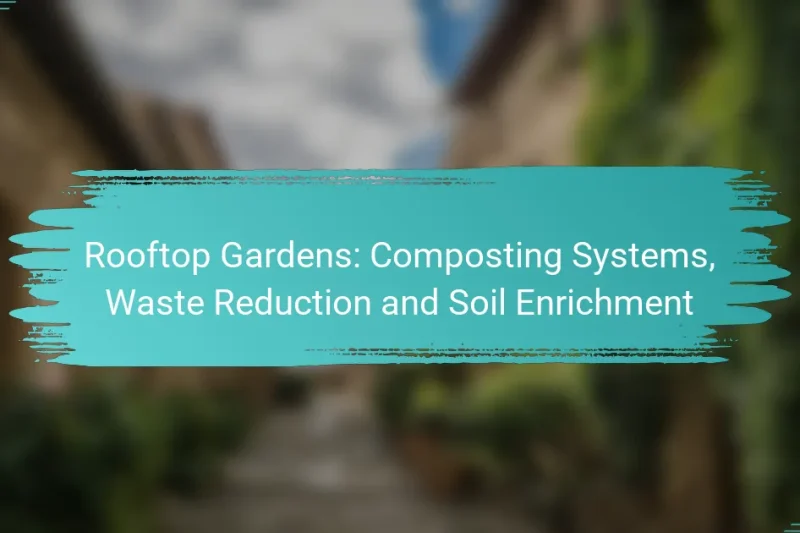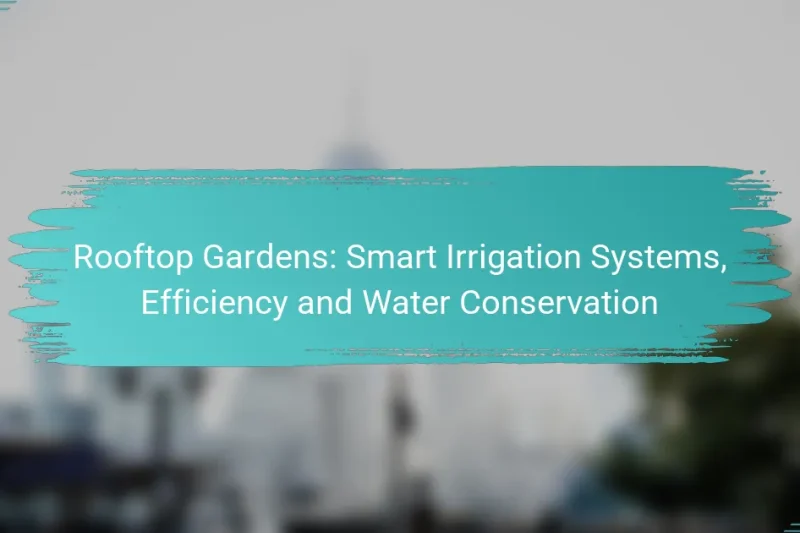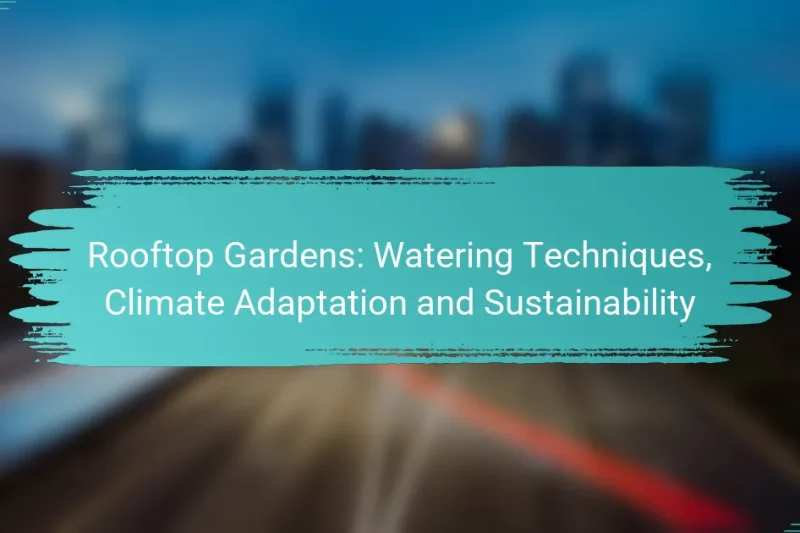Rooftop gardens are an innovative way to enhance urban green spaces, and utilizing eco-friendly fertilizers is … Rooftop Gardens: Eco-Friendly Fertilizers, Soil Health and Plant GrowthRead more
Maintenance of Rooftop Gardens
Maintaining rooftop gardens in urban environments presents unique challenges, such as limited space and variable weather conditions. Successful upkeep involves regular watering, soil health management, and the selection of resilient plants that thrive in these settings. Thoughtful design and seasonal maintenance are essential to create a vibrant and functional green space atop city buildings.
Rooftop Gardens vs. Ground-Level Gardens: Maintenance Costs and Benefits
Rooftop gardens and ground-level gardens each present unique maintenance costs and benefits that are crucial for … Rooftop Gardens vs. Ground-Level Gardens: Maintenance Costs and BenefitsRead more
Rooftop Gardens: Composting Systems, Waste Reduction and Soil Enrichment
Rooftop gardens play a vital role in urban sustainability by transforming unused spaces into green havens … Rooftop Gardens: Composting Systems, Waste Reduction and Soil EnrichmentRead more
Rooftop Gardens: Native Plants, Maintenance Reduction and Biodiversity
Rooftop gardens play a crucial role in enhancing urban biodiversity by creating habitats for various species … Rooftop Gardens: Native Plants, Maintenance Reduction and BiodiversityRead more
Rooftop Gardens: Smart Irrigation Systems, Efficiency and Water Conservation
Rooftop gardens are increasingly benefiting from smart irrigation systems that enhance water conservation and promote plant … Rooftop Gardens: Smart Irrigation Systems, Efficiency and Water ConservationRead more
Rooftop Gardens: Watering Techniques, Climate Adaptation and Sustainability
Rooftop gardens are innovative solutions that enhance urban environments by promoting sustainability and improving plant health … Rooftop Gardens: Watering Techniques, Climate Adaptation and SustainabilityRead more
How to maintain rooftop gardens in urban areas?
Maintaining rooftop gardens in urban areas requires a tailored approach that considers limited space, varying sunlight, and potential wind exposure. Key practices include establishing regular watering schedules, ensuring soil health, selecting appropriate plants, and implementing seasonal maintenance tasks.
Regular watering schedules
Establishing a regular watering schedule is crucial for rooftop gardens, as they often experience higher evaporation rates due to sun exposure and wind. Aim to water plants early in the morning or late in the afternoon to minimize water loss. Depending on the plant types and weather conditions, watering may be needed daily or every few days.
Consider installing a drip irrigation system to automate watering, which can save time and ensure consistent moisture levels. Monitor the soil moisture regularly to adjust your schedule as needed.
Soil health management
Healthy soil is the foundation of a thriving rooftop garden. Use a lightweight, well-draining soil mix that retains moisture but allows excess water to escape. Regularly test the soil pH and nutrient levels to ensure optimal growing conditions.
Incorporate organic matter, such as compost, to improve soil fertility and structure. This not only enhances nutrient availability but also supports beneficial microorganisms that promote plant health.
Plant selection for climate
Selecting the right plants for your rooftop garden is essential, especially in urban areas where climate conditions can vary significantly. Choose drought-resistant and heat-tolerant species that can thrive in the specific microclimate of your rooftop.
Consider native plants, as they are typically better adapted to local conditions and require less maintenance. Group plants with similar water and sunlight needs to simplify care and improve overall garden health.
Seasonal maintenance tasks
Seasonal maintenance is vital for the longevity of rooftop gardens. In spring, focus on planting new species and applying mulch to retain moisture. Summer tasks include regular watering and monitoring for pests.
In fall, prepare plants for winter by trimming back perennials and cleaning up debris. During winter, protect sensitive plants from extreme cold with appropriate coverings or by relocating them if possible.
Pest control strategies
Effective pest control is essential for maintaining a healthy rooftop garden. Regularly inspect plants for signs of pests and diseases, such as discolored leaves or unusual growth patterns. Early detection allows for prompt action.
Utilize integrated pest management (IPM) strategies, which may include introducing beneficial insects, using organic pesticides, or employing physical barriers. Avoid chemical treatments that can harm beneficial organisms and the urban environment.
What are the best plants for rooftop gardens?
The best plants for rooftop gardens are those that thrive in limited soil depth and can withstand varying weather conditions. Considerations include drought resistance, culinary uses, and native plant species that require less maintenance.
Succulents for drought resistance
Succulents are ideal for rooftop gardens due to their ability to store water in their leaves, making them highly drought-resistant. Varieties such as Sedum, Echeveria, and Aloe Vera can thrive in sunny environments with minimal watering.
When selecting succulents, ensure they are suited for your climate zone. In warmer regions, opt for varieties that can handle intense sunlight, while cooler areas may benefit from hardier types that can tolerate lower temperatures.
Herbs for culinary use
Herbs are a practical choice for rooftop gardens, providing fresh ingredients for cooking while also enhancing the garden’s aesthetic. Popular options include basil, rosemary, thyme, and mint, which can flourish in containers or small beds.
When planting herbs, consider their sunlight and water needs. Most herbs thrive in full sun and require well-drained soil. Regular harvesting encourages growth, so be sure to trim them back to promote bushier plants.
Native plants for low maintenance
Native plants are excellent for rooftop gardens as they are adapted to local conditions and typically require less water and care. Species such as coneflowers, black-eyed Susans, and ornamental grasses can provide beauty while supporting local wildlife.
Choosing native plants reduces the need for fertilizers and pesticides, making maintenance easier. Research local native plant lists to find varieties that will thrive in your specific environment and climate.
How to design a rooftop garden layout?
Designing a rooftop garden layout involves careful planning to optimize space, aesthetics, and functionality. Consider factors such as sunlight exposure, wind patterns, and accessibility to create a harmonious and practical garden environment.
Layering plants for aesthetics
Layering plants in a rooftop garden enhances visual appeal and creates a dynamic landscape. Use a combination of tall, medium, and low-growing plants to add depth and interest. For example, place taller plants like sunflowers or ornamental grasses at the back, with shorter flowers or ground covers in the front.
Consider seasonal variations by selecting plants that bloom at different times throughout the year. This approach ensures that your rooftop garden remains vibrant and engaging, regardless of the season.
Incorporating seating areas
Seating areas in a rooftop garden provide a space for relaxation and enjoyment of the surroundings. Choose durable outdoor furniture that can withstand weather conditions, such as metal or treated wood. Arrange seating to maximize views and create inviting spots for socializing or quiet reflection.
To enhance comfort, consider adding cushions or outdoor rugs. Ensure that seating areas are accessible and that pathways are wide enough to accommodate movement without obstruction.
Water feature options
Water features can add tranquility and visual interest to a rooftop garden. Options include small fountains, ponds, or even wall-mounted water installations. When selecting a water feature, consider the size of your space and the maintenance requirements.
For a low-maintenance option, consider a self-contained fountain that recirculates water. Ensure that any water feature complies with local regulations regarding drainage and water use to avoid potential issues.
What are the costs associated with rooftop garden maintenance?
The costs associated with rooftop garden maintenance can vary widely based on factors such as size, location, and the types of plants used. Generally, these costs can be categorized into initial setup costs and ongoing maintenance expenses, both of which are essential for a thriving garden.
Initial setup costs
Initial setup costs for a rooftop garden typically include materials, labor, and design expenses. Depending on the complexity, these costs can range from a few hundred to several thousand dollars. Key components often involve soil, drainage systems, plants, and structural reinforcements.
For example, a basic setup with lightweight soil and a few planters may cost around $500, while a more elaborate design with irrigation systems and diverse plant selections can exceed $5,000. It’s crucial to assess your rooftop’s structural capacity and local regulations before starting.
Ongoing maintenance expenses
Ongoing maintenance expenses encompass regular tasks such as watering, fertilizing, pruning, and pest control. These costs can range from $50 to several hundred dollars per month, depending on the garden’s size and plant variety. Hiring professionals for maintenance can significantly increase these expenses.
Homeowners can reduce costs by performing routine tasks themselves, such as watering and weeding. However, it’s essential to factor in seasonal changes, which may require more intensive care during peak growing months.
Cost-saving tips for urban gardeners
Urban gardeners can implement several cost-saving strategies to manage their rooftop garden expenses effectively. One effective approach is to choose native plants that require less water and maintenance, which can lower ongoing costs.
Additionally, consider using rainwater harvesting systems to reduce water bills and investing in composting to minimize fertilizer costs. Joining a community gardening group can also provide access to shared resources and knowledge, further reducing individual expenses.
What tools are essential for rooftop garden upkeep?
Essential tools for rooftop garden upkeep include hand tools, efficient watering systems, and soil testing kits. These tools help ensure that your garden remains healthy and productive, even in limited space.
Hand tools for small spaces
Hand tools are crucial for maintaining rooftop gardens, especially in tight areas. Essential tools include trowels, pruners, and hand rakes, which allow for precise work without damaging surrounding plants.
When selecting hand tools, consider lightweight options that are easy to maneuver. Look for ergonomic designs to reduce strain during prolonged use. A small tool set can often suffice for most tasks, making it easier to store and transport.
Watering systems for efficiency
Efficient watering systems are vital for rooftop gardens, where access to water may be limited. Drip irrigation systems are highly recommended as they deliver water directly to the plant roots, minimizing waste and ensuring consistent moisture levels.
Alternatively, self-watering planters can be a practical choice for smaller gardens. These systems reduce the frequency of watering while maintaining optimal soil moisture. Be mindful of local water regulations and consider using rainwater collection systems to enhance sustainability.
Soil testing kits for health
Soil testing kits are important for assessing the health of your rooftop garden’s soil. These kits typically measure pH levels, nutrient content, and soil composition, helping you understand what amendments may be necessary for optimal plant growth.
Regular testing, ideally once or twice a year, can guide your fertilization and soil amendment strategies. Look for kits that provide clear instructions and reliable results, and consider sending samples to local agricultural extensions for more detailed analysis if needed.
How to choose a rooftop garden maintenance service?
Selecting a rooftop garden maintenance service involves assessing their expertise, reliability, and the specific services they offer. Look for companies that specialize in urban gardening and have experience with the unique challenges of rooftop environments.
Evaluate experience and expertise
When choosing a maintenance service, prioritize companies with a proven track record in rooftop gardens. Check their portfolio for previous projects and client testimonials to gauge their reliability and skill level.
Consider whether they employ certified horticulturists or landscape professionals who understand the specific needs of rooftop plants and sustainable practices.
Assess service offerings
Different maintenance services provide varying levels of care. Some may offer basic upkeep, while others include comprehensive packages with pest management, irrigation systems, and seasonal planting.
Clearly define your needs and compare the services offered by different providers to ensure they align with your garden’s requirements.
Check for insurance and certifications
Ensure that the maintenance service is fully insured and holds relevant certifications. This protects you from liability in case of accidents and ensures that the service adheres to industry standards.
Look for certifications from recognized organizations in horticulture or landscaping, which can indicate a commitment to quality and safety.
Request quotes and compare pricing
Obtain quotes from multiple maintenance services to compare pricing. Be cautious of prices that seem too low, as they may reflect lower quality service or hidden fees.
Consider the value of the services offered rather than just the cost. A slightly higher price may be justified by better expertise or more comprehensive care.





